Beijing Law Review, 2020, 11, 128-143
https://www.scirp.org/journal/blr
ISSN Online: 2159-4635
ISSN Print: 2159-4627
Comparison of Labor Laws in China,
Russia, and the US
Richard A. Posthuma
Department of Marketing and Management, College of Business Administration, University of Texas at El Paso, El Paso,
TX, USA
How to cite this paper: Posthuma, R. A.
(2020). Comparison of Labor Laws in Chi-
na, Russia, and the US. Beijing Law Review,
11, 128-143.
https://doi.org/10.4236/blr.2020.111009
Received: January 7, 2020
Accepted: February 7, 2020
Published: February 10, 2020
Copyright © 2020 by author(s) and
Scientific Research Publishing Inc.
This work is licensed under the Creative
Commons Attribution International
License (CC BY 4.0).
http://creativecommons.org/licenses/by/4.0/
Open Access
Abstract
This article compares labor laws in China, Russia, and the US. It demon-
strates how mimetic isomorphic tendencies and general principles of fairness
such as equality, equity, and need may have resulted in similarities in the la-
bor laws across all 3 countries. However, it is also shown that unique cultural,
social, and historical factors have created significant differences in these labor
laws. Understanding these differences will inform policy makers and business
leaders.
Keywords
Labor Laws, China, Russia, US Comparative Laws
1. Why Study Comparative Labor Laws?
The importance of comparing labor laws across different countries is based on
two factors. The first reason is the ubiquity of the employment relationship
across different countries. Local employers provide the majority of jobs in most
countries. Yet the laws in each country are sometimes similar and sometimes
very different. In addition, as Multinational Enterprises (MNEs) move into dif-
ferent countries, they often encounter labor laws different than in their home
country (Dowling Jr., 2001). MNEs need to be able to understand, adapt, and
adjust to the differences as they expand their operations and hire more local em-
ployees that are covered by different labor laws (Brown, 2012).
The second reason is the need for governments to regulate the relationship
within their own borders. The study of comparative labor laws enables policy
makers to be more informed about successful models of employment regulation
in other countries (Lee, McCann, & Messenger, 2007).
DOI: 10.4236/blr.2020.111009 Feb. 10, 2020
128
Beijing Law Review
�
R. A. Posthuma
1.1. Research Problem and Objective
Unfortunately, prior research has not sufficiently explicated the differences and
similarities of labor laws in different countries. A potential problem with this is
that MNEs may not adequately understand the laws of other countries. When
this happens, they can be accused of violating the laws of the countries in which
they operate. Recent reports suggest that this may have occurred with major
MNEs operating in China (Brown, 2019). Therefore, it is important to carefully
analyze the similarities and differences in labor laws in different countries so
that MNEs will understand how to comply with foreign laws. The result will be
an increase in international economic cooperation and growth. In addition, the
study of comparative labor laws is needed so that governments can benefit from
an understanding of how their labor laws compare to those of other countries.
Prior research has generally described the provisions of laws in single coun-
tries. For example, prior research has described the changes in China’s labor law
that took place in 2008 (Harper, 2009; Jing, 2009; Wang, 2009).
Other work has examined the differences between labor laws under the Soviet
Union and more contemporary laws under the Russian Federation (Bliss, 1997);
and also the application of international labor laws in Russia (Deak, 1995).
Nevertheless, what is clearly needed is a direct comparison of similar provi-
sions of labor laws in different countries. That analysis is done in this article.
1.2. Research Method and Approach
Preparation of the analysis reported in this study began with discussions with
practicing managers in China, Russia, and the US they were asked about the key
labor laws in their own countries. Then, a review of the literature on the labor
laws in China, Russia and the US was conducted. This review focused on the
specific provisions of labor laws that are most common across countries and
cultures (Pull, 2002). In addition, special attention was given to recent changes
in the labor laws in these countries (e.g. Franceschini, 2020; Mahy, Mitchell, Su-
therland et al., 2019). Information about the recent changes was confirmed by
searching the online information available for law firms that practice labor laws
in different countries (e.g., Isaacs, Lu, & An, 2019). Then, a summary of the laws
in these 3 countries was prepared. Comparing and contrasting the provisions
across countries was an important goal of this method.
1.3. Ubiquity of the Employment Relationship
People work for employers all across the globe. It has been estimated that there
are more than 3 billion people who are involved in an employment relationship
(Torres, 2013). At the most fundamental level, this employment relationship is a
two-party consensual exchange in which an employee agrees to provide labor in
return for wages and benefits from their employer. In this way, the employee
meets his or her interests in obtaining income, and the employer meets its inter-
est in obtaining the services of the worker. So long as the employee and employ-
129
Beijing Law Review
DOI: 10.4236/blr.2020.111009
�
R. A. Posthuma
DOI: 10.4236/blr.2020.111009
er both see the relationship as being in their own self-interest, they will volunta-
rily engage with each other in the work-for-compensation transaction that is the
essence of employment.
Not surprisingly, this symbiotic relationship is permitted and encouraged by
governments in every country across the world. Not only does it provide benefits
to both parties (employee and employer) but also provides benefits to other
stakeholders. This includes the employee’s family members who vicariously
benefit from the economic rewards of the employee’s labor (Garcia, Posthuma,
& Quinones, 2010). It also benefits the employer’s stakeholders, such as its cus-
tomers, who receive the products and services provided by the employer, owners
who share the profits, and the communities where the employer provides jobs
thereby enhancing general economic conditions.
Yet, the interests of employees and employers do not always converge. Em-
ployees want higher wages, better benefits, and better job security; but employers
want lower costs, as well as more output and better quality of work from their
employees. In some situations, there are asymmetrical advantages that can favor
one party over the other. For example, where there are few jobs and many appli-
cants for those jobs, employers could drive down wages, and provide work envi-
ronments that are less desirable or less safe than they otherwise could be, thereby
exploiting their workers.
In other situations, jobs are plentiful and workers are scarce. When this oc-
curs, employees sometimes have the potential to engage in self-serving counter-
productive behaviors that can be detrimental to their employers. This can in-
clude taking advantage of the employment relationship by quitting their job and
going to work for a competitor, with very little notice, causing disruption to the
employer’s operations. In other circumstances employees could take important
business knowledge with them as they leave, causing harm to their previous em-
ployer.
1.4. Labor Laws in Different Countries
Governments in every country have recognized the potential for exploitation
that could harm workers, and also for employee counterproductive behaviors
that could harm employers. In response they have adopted legal protections to
prevent worker exploitation (Posthuma, Flores, Dworkin, & Pavel, 2016), and
protections for employers to restrict counterproductive employee behaviors
(Posthuma, Dworkin, Torres, & Bustillos, 2000). However, every country has
adopted its own unique set of labor laws based on its own cultural and historical
influences (Cooney, Gahan, & Mitchell, 2011; Roehling, Posthuma, & Hickox,
2008). Some laws are designed to require adequate working conditions and pro-
tect worker rights (Posthuma & Ebert, 2011). Others are designed to prohibit
discrimination against employees based on demographic differences (Cheng,
Flores, Singh & Posthuma, 2018; Tiefenbrun, 2017).
However, one thing is clear. The labor laws of one country generally do not
130
Beijing Law Review
�
R. A. Posthuma
apply in another country (Posthuma, Roehling, & Campion, 2006). Thus, al-
though the employment relationship is globally ubiquitous, the laws regulating
that relationship are exclusive to each country. That is one reason that the labor
laws of a country are often a reflection of the unique history and culture of that
country. There are two implications of this wide variety of labor laws across the
globe.
The first implication of the wide variety of labor laws is that it is important to
understand the similarities across countries where they do exist. The identifica-
tion of similarities enables broad conclusions and agreement about the funda-
mental principles that are globally applicable across countries.
The most important principle is that employment laws can promote fairness
in the employment relationship. A commonly used model of justice suggests that
there are three universally applicable criteria to assess fairness: equality, equity,
and need (Rawls, 1971). Each of these three criteria can be used to explain how
fairness in the employment relationship can be achieved through the adoption of
certain types of labor laws.
The equality principle justifies laws that require all employees will receive the
same outcome, as in Russia, where all employees receive a minimum of 28 days
of paid vacation per year. This is an example of equality because all employees
receive at least the same basic minimum.
The equity principle justifies laws that require employees to receive different
outcomes based on some legitimate and objective criteria. For example, the eq-
uity principle explains the fairness of laws that require employees who have
stayed working for the same employer should be rewarded with more vacation
days, as they are in China. This is an example of equity because those who have
remined loyal to the same company are rewarded with more vacation.
The need principle justifies laws that require better outcomes for employees
who have greater needs. For example, Russian labor law provides special protec-
tions for pregnant women and nursing mothers. This helps to meet the special
needs that they have as they give birth and raise children.
The second implication of the variety of labor laws across countries is the im-
portance of specifying the differences in labor laws across countries. The identi-
fication of differences enables comparisons and contrasts that can identify alter-
native provisions for policy makers could consider adopting in their own coun-
tries. It can also suggest possible benefits that employers could provide to their
workers even though they are not legally required to do so. However, they could
voluntarily provide additional benefits in order to attract and retain a loyal
workforce. A partial justification for providing the types of benefits that are
identifying by comparing labor laws is that they different provisions have been
perceived as important and legitimate in other countries.
For example, in the US there no generally applicable federal law that required
paid family leave in the private sector. However, other countries such as China
and the Russian Federation (hereinafter “Russia”) do require this type of benefit.
131
Beijing Law Review
DOI: 10.4236/blr.2020.111009
�
R. A. Posthuma
DOI: 10.4236/blr.2020.111009
China provides 128 days of paid family leave (Jia, Dong, & Song, 2018), and
Russia provides 140 days of paid family leave (Addati, Cassirer, & Gilchrist,
2014; IBP, 2016). By comparison even though the US does not generally require
this form of paid leave, U.S, employers could voluntarily choose to adopt a poli-
cy that would, and many have done so.
Therefore, it is important to study labor laws in different countries. This paper
compares labor laws in China, Russia, and the US. These countries were chosen
because they each have a large workforce, have developed their labor laws for
many years, continue to make changes in those laws (Gerasimova, Korshunova,
& Chernyaeva, 2017), and have significant similarities and differences in how
they approach the regulation of the employment relationship.
2. Similarities in the Structure and Sources
of Labor Laws across Countries
There are several general similarities in employment law provisions across dif-
ferent countries. Two of these similarities are the structure of labor laws and the
sources of labor laws.
First, in each country there are country-wide federal laws, and also local laws
with different standards. In China, Russia, and the US there are standardized
federal labor laws that provide a certain level of protection to workers that are
the same across the whole country (Demidov, 2019). However, each country also
has labor laws that are somewhat different in political subdivisions within a
country such as provinces, regions, states, or cities (Posthuma, 2012). It is also
noteworthy that in each country the differences usually provide greater protec-
tions for workers at the local level than the protections available at the national
level. Thus, each country has recognized the importance of balancing the needs
for country-wide standardization, with the desire for local governments to pro-
vide some additional protections to workers in their region (Brown, 2010, 2012;
Yang, 2017).
Second, in each country there are several similar sources of labor laws. These
begin with the country’ constitution; and then includes federal labor laws, proc-
lamations from the chief executive of the country, decisions from courts, and
regulations from administrative agencies that focus on particular topics such as
equal employment opportunity, methods for payment of wages, safety, etc. (IBP,
2016; Yang, 2017; Sychenko, 2019).
Thus, despite the cultural and historical differences across countries, there is a
degree of mimetic isomorphism in the methods whereby labor laws are created.
Mimetic isomorphism is a theory that predicts that one organization will copy
the structures that it sees another organization using when it believes that it has
worked well for the other organization (Dimaggio & Powell, 1983). Although
this theory has been shown to explain why one company will copy the structures
of another company, it may also explain why one country adopts the structural
elements of labor laws used in another country. Moreover, these similarities can
132
Beijing Law Review
�
R. A. Posthuma
include similar provisions in labor laws themselves. For example, if a country
sees that other countries have established minimum wage levels for the benefit of
their workers, they could adopt them in their own country too. There are several
examples of this in China, Russia, and the US.
2.1. Similarities in Protections and Benefits for Workers
Given the similarities of the structure and sources of labor laws in different
countries it is not surprising that the historical influences that affect the adop-
tion of regulatory environments in different countries have resulted in similar
laws in China Russia, and the US (Cooney et al., 2011; Roehling et al., 2008).
Moreover, each country has enacted several similar laws that meet the univer-
sally accepted principles of fairness of equality, equity, and need.
Minimum Wage: Each country has national provisions for a minimum wage
level, with some differences at the local level within specific jurisdictions. Also,
as time passes each country has raised the level of minimum wages. This is an
example of the universality of the equality-based principle of fairness. All 3
countries recognize that employees should be paid at least some equal level of
wages.
Overtime Pay: Also, each country requires that employees be paid at 1.5
tunes the regular rate of pay for overtime, or hours worked above a certain level.
However, the eligibility for overtime pay varies across countries. In China over-
time pay applies for hours worked over 8 per day or 40 per week (Boguen, 2019).
In Russia and the US overtime pay applies for hours worked over 40 per week.
This is an example of the universality of the equity-based principle of fairness.
All 3 countries recognize that above a certain number of hours worked em-
ployees have earned the right to be paid a higher wage rate.
Social Insurance Payroll Taxes: In addition, each country also requires the
payment of taxes based on the amount of wages that employees receive. These
taxes are designed to fund programs for social insurance, retirement, etc. that
workers may be entitled to receive at some point in their lives. This is an exam-
ple of the need-based principle of fairness. All 3 countries recognize that em-
ployees will, at some time in their lives, e.g., at retirement, need some financial
support that goes beyond the wages and benefits that their employer provides.
These are all interesting and important protections for workers. Most prior
research tends to focus almost exclusively on the degree to which labor laws
provide protections for workers. This is an important topic. However, since em-
ployment is a relationship between workers and employers it necessary to con-
sider the impact of labor laws on employers as well. That is the focus of the fol-
lowing section (Wang, 2009).
2.2. Similarities in Protections and Benefits for Employers
There are also some similarities in the types of protections that employers are
afforded against the possible counterproductive behaviors of workers.
133
Beijing Law Review
DOI: 10.4236/blr.2020.111009
�
R. A. Posthuma
DOI: 10.4236/blr.2020.111009
In all 3 countries, employers have the right to choose whom to hire, although
this right has limitations. Also, in all 3 countries, employers can unilaterally end
the employment relationship even without the consent of the employee. Howev-
er, each country has very different restrictions on this right.
In the US the general rule is something called “employment-at-will”. Under
this general common law principle either the employee or the employee can end
the employment relationship without the requirement of proving that they had a
good and legal justification for doing so. However, there are several categories of
employees that have greater protections, such as teachers who have tenure, em-
ployees who are covered by a collective bargaining agreement, government em-
ployees, etc. For those employees it is generally required that the employer be
able to show that they have established rules, the employee knew about the rules,
and that the employee violated the rules. This can be referred to as the require-
ment of having a “just cause” for employment termination. The labor laws in
China and Russia do not follow the employment-at-will principle. Their laws are
closer to the just cause requirement that applies to some employees in the US.
In China it is easier for employers to terminate an employee during their ini-
tial probationary period. After that, the employer may agree with the employee
to establish a fixed term employment contract for a limited period of time, or for
an open-ended contract with no fixed time limit (Boguen, 2019; Yang, 2017).
Ending the employment relationship after the probationary period generally re-
quires that the employer has established work rules, that the employee knew
about the rules, and that the employee violated these rules.
Russia also has similar laws. These laws generally require the employer to
prove that the employer has committed serious violations of work rules
(Gerasimova, Korshunova, & Chernyava, 2017; IBP, 2016).
In each country there are some protections for workers and some protections
for employers. However, the labor laws provide more protections for employees
than they do for employers. This difference is primarily the result of need-based
fairness. Typically, employers have greater potential power in the employment
relationship because they can replace employees with other people. This creates
an asymmetrical power imbalance that favors employers over employees. Thus,
employees have a greater need for protection in the employment relationship
than do employers. This need is met by the governments in each country pro-
viding some protections for workers.
2.3. Comparisons of Similarities across Countries
The labor laws in different countries have similar structural foundations; and
also the sources of those labor laws tend to be similar. The structural founda-
tions include standardized laws across the whole country with adaptations in lo-
cal political jurisdictions. The similarities also include a national constitution,
federal labor laws, etc. This suggests that the mimetic isomorphism perspective
may provide an explanatory rationale for how labor laws developed across the
134
Beijing Law Review
�
R. A. Posthuma
globe.
Yet, even within the similarities of structural foundations and sources of labor
laws, there remain unique differences. For example, although all three countries
include a minimum wage, and provisions to increase the minimum wage over
time, the actual minimum wage levels are quite different in the different coun-
tries. This indicates that the pressures of mimetic isomorphism are at least
somewhat constrained by other pressures such as the economic conditions in
each country. This also suggests that even though the equality-based principle of
treating all employees similarly may provide a justification for minimum wages,
the equality that is provided is equal within their own country, and not equal to
what is provided in other countries. Thus, the scope of the standard of compari-
son for equality fairness may be limited to the borders of each country.
Also, the substantive protections of some labor laws do show some consisten-
cies. For example, all countries provide overtime pay, the provisions are similar
in that they require overtime pay at 40 hours worked per week; but only China
also requires overtime pay at 8 hours worked per day. This suggests that the eq-
uity-based principle of treating employees differently based on what they have
earned based on the number of hours worked, has been enacted somewhat dif-
ferently in different countries.
With respect to the similarities of protections and benefits for employers,
these too may have been, in part, the result of mimetic isomorphism processes.
As employers recognize the problems that can occur if they have difficulties in
ending the employment of unproductive workers, it is logical that they would
urge their government to provide them with some flexibility under their labor
laws. However, despite some similarities across countries in this regard, there
remain significant differences. By comparing China, Russia, and the US we can
see that both China and Russia provide more protections for workers from un-
just termination than is provided in the US. Although China and Russia go
about it differently, they both provide a type of just cause standard that is not
generally applicable in the US. It could be argued that the need-based type of
fairness is more strongly supported by the provisions of laws in China and Rus-
sia, than in the US.
Thus, it can be observed that the mimetic isomorphism tendencies and gener-
ally accepted principles of fairness may explain many similarities across coun-
tries, but there remain significant differences.
3. Differences in Labor Laws across Countries
Despite the tendencies of these 3 countries to engage in isomorphic adoption of
similar laws on some topics based on similar fundamental principles of fairness,
there nevertheless remain significant differences as well.
3.1. Differences in Protections and Benefits for Workers
Holidays: All 3 countries have some form of recognition for the possibility of
135
Beijing Law Review
DOI: 10.4236/blr.2020.111009
�
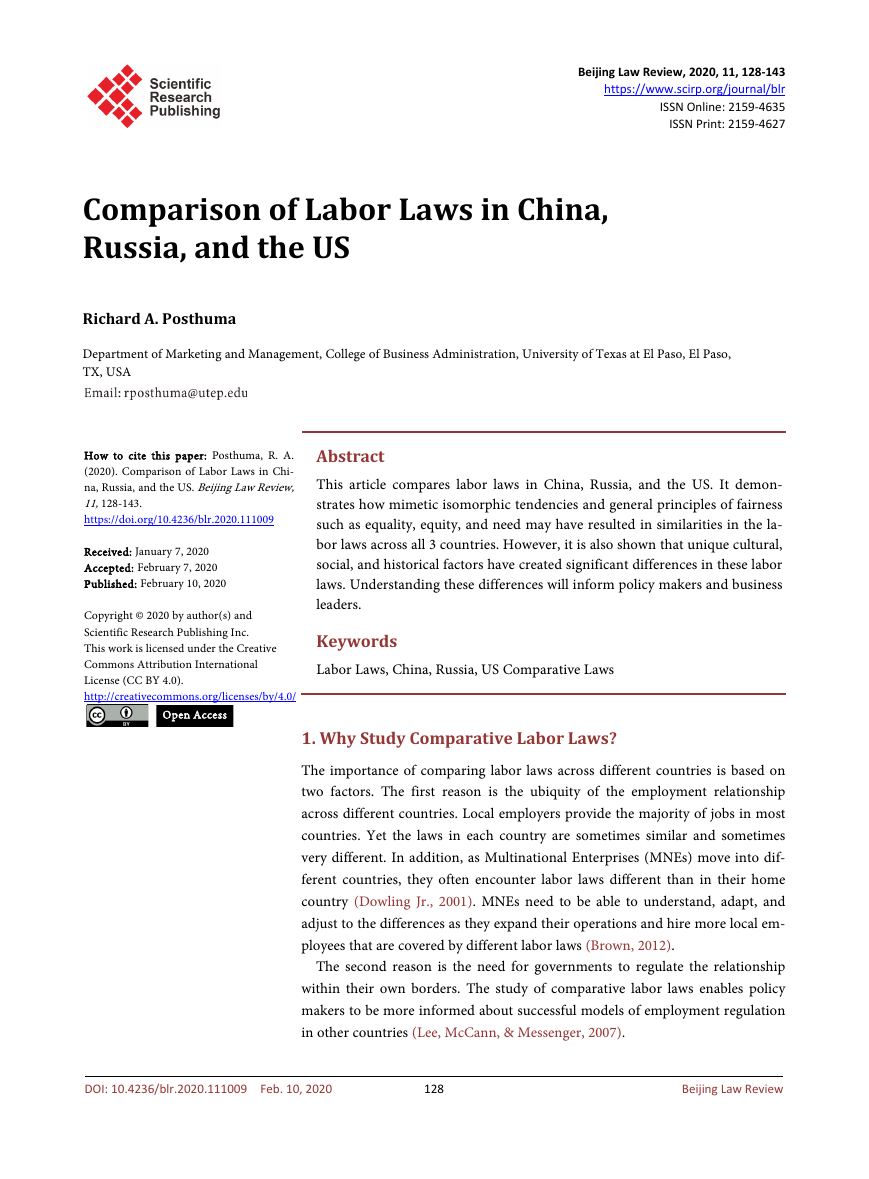


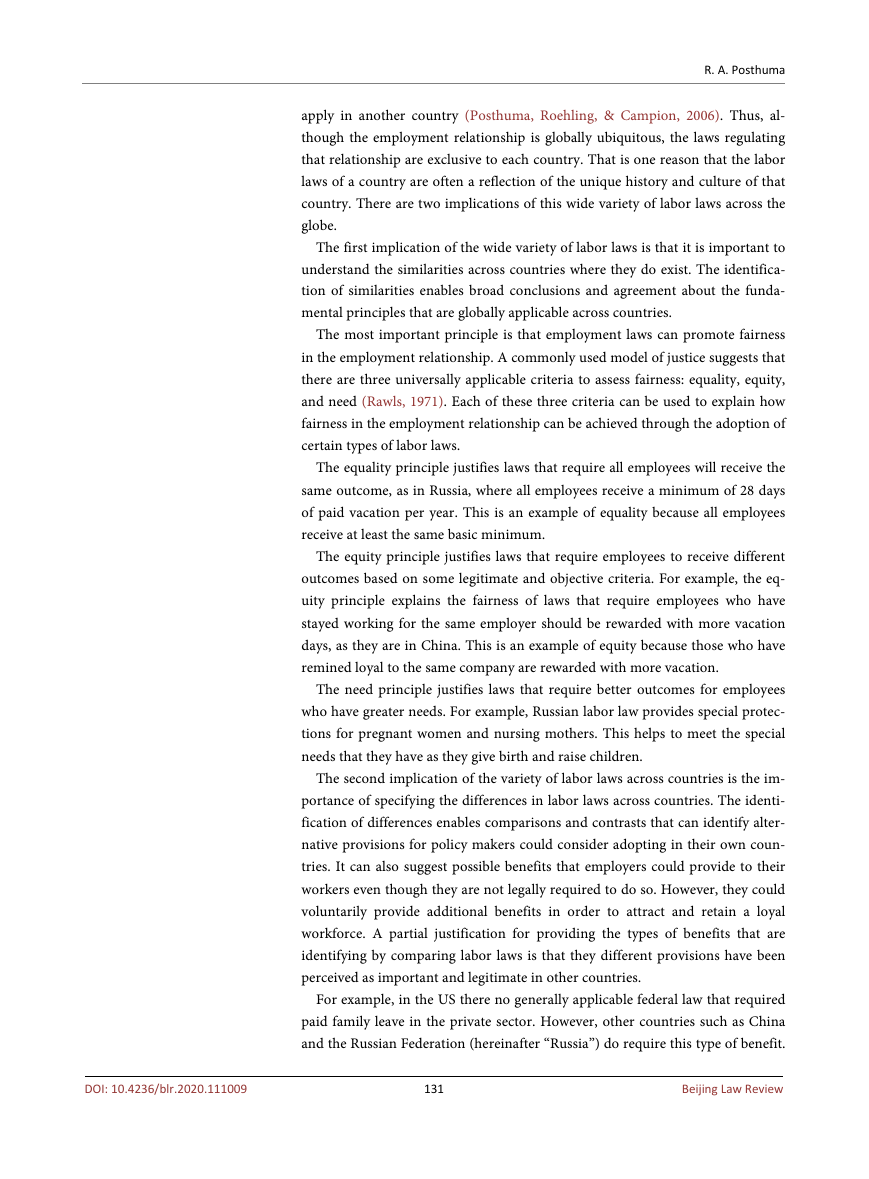

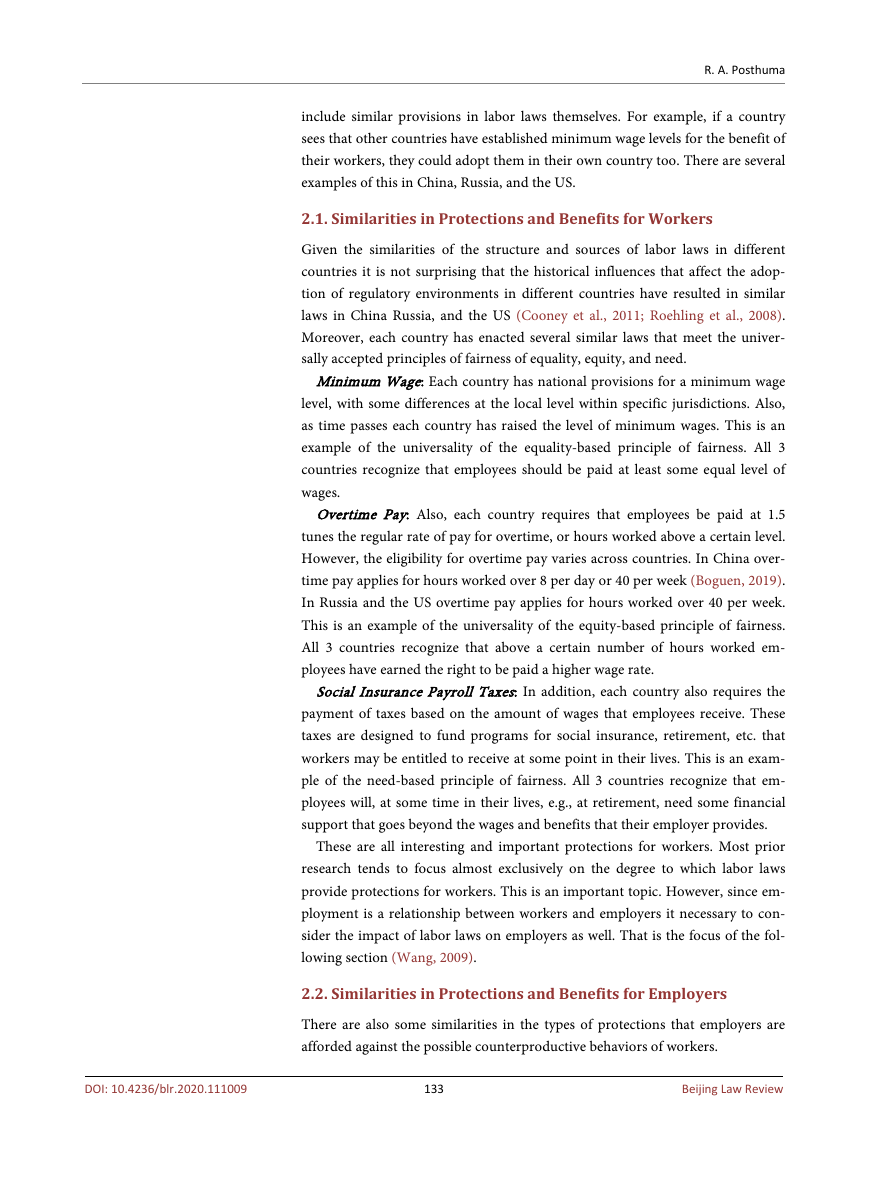
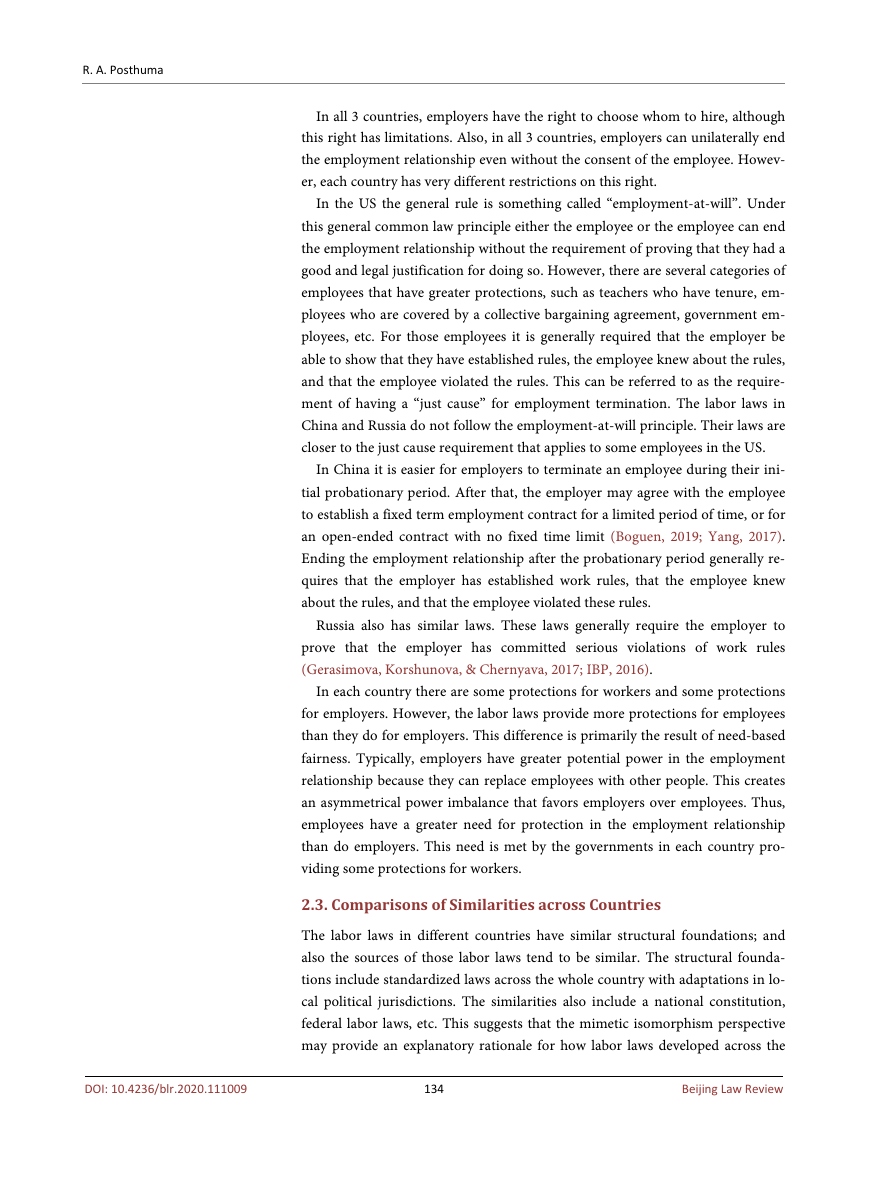
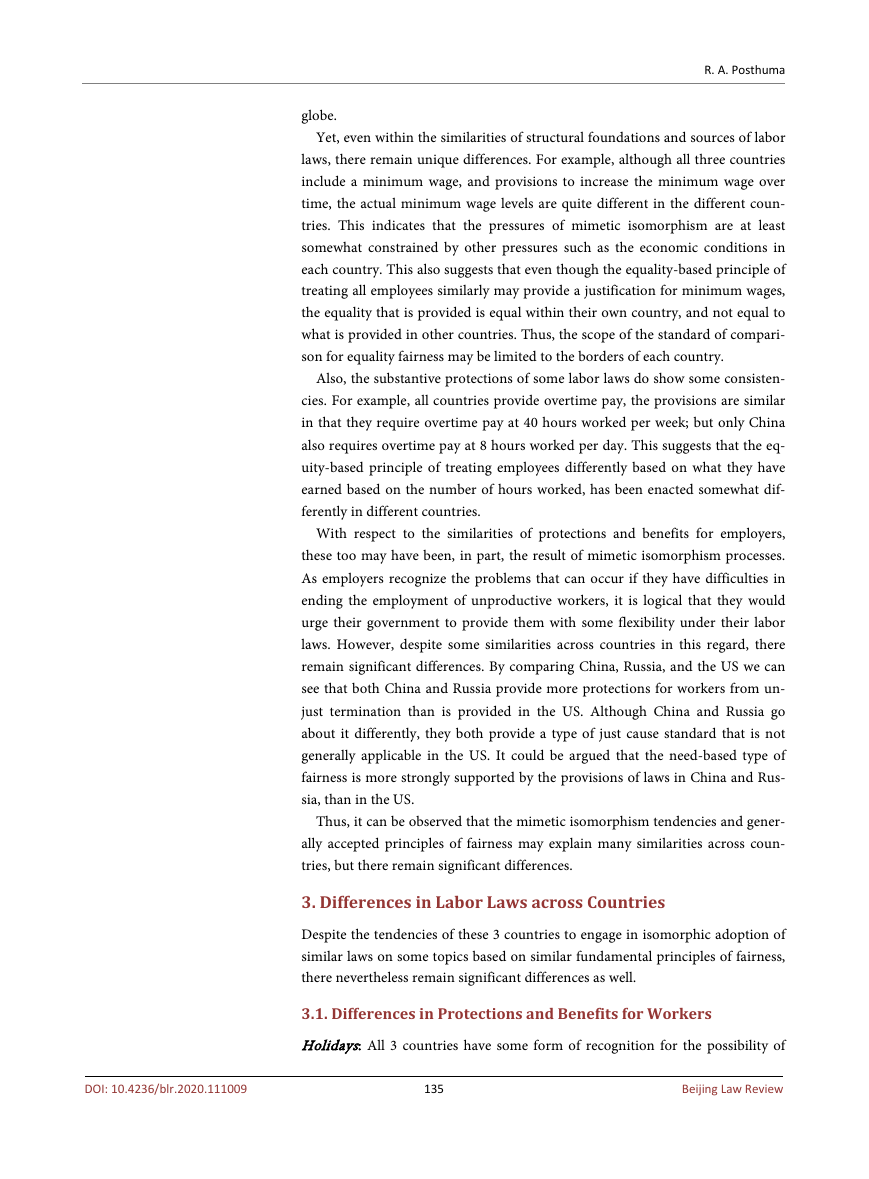








 2023年江西萍乡中考道德与法治真题及答案.doc
2023年江西萍乡中考道德与法治真题及答案.doc 2012年重庆南川中考生物真题及答案.doc
2012年重庆南川中考生物真题及答案.doc 2013年江西师范大学地理学综合及文艺理论基础考研真题.doc
2013年江西师范大学地理学综合及文艺理论基础考研真题.doc 2020年四川甘孜小升初语文真题及答案I卷.doc
2020年四川甘孜小升初语文真题及答案I卷.doc 2020年注册岩土工程师专业基础考试真题及答案.doc
2020年注册岩土工程师专业基础考试真题及答案.doc 2023-2024学年福建省厦门市九年级上学期数学月考试题及答案.doc
2023-2024学年福建省厦门市九年级上学期数学月考试题及答案.doc 2021-2022学年辽宁省沈阳市大东区九年级上学期语文期末试题及答案.doc
2021-2022学年辽宁省沈阳市大东区九年级上学期语文期末试题及答案.doc 2022-2023学年北京东城区初三第一学期物理期末试卷及答案.doc
2022-2023学年北京东城区初三第一学期物理期末试卷及答案.doc 2018上半年江西教师资格初中地理学科知识与教学能力真题及答案.doc
2018上半年江西教师资格初中地理学科知识与教学能力真题及答案.doc 2012年河北国家公务员申论考试真题及答案-省级.doc
2012年河北国家公务员申论考试真题及答案-省级.doc 2020-2021学年江苏省扬州市江都区邵樊片九年级上学期数学第一次质量检测试题及答案.doc
2020-2021学年江苏省扬州市江都区邵樊片九年级上学期数学第一次质量检测试题及答案.doc 2022下半年黑龙江教师资格证中学综合素质真题及答案.doc
2022下半年黑龙江教师资格证中学综合素质真题及答案.doc